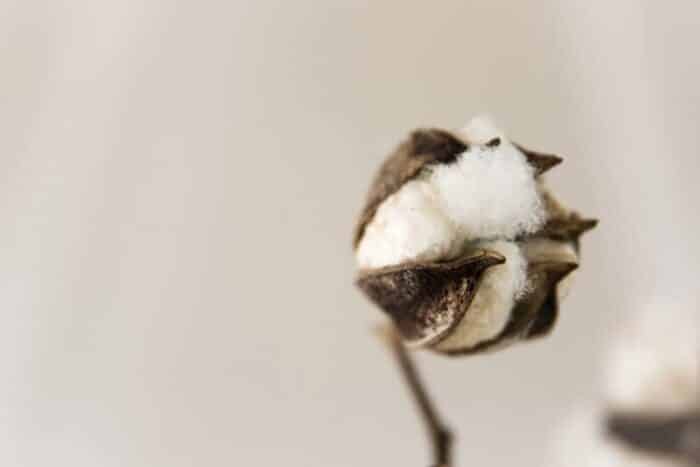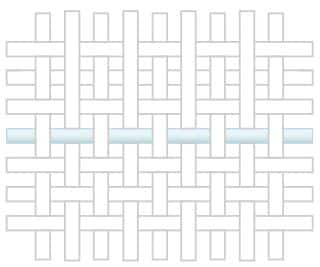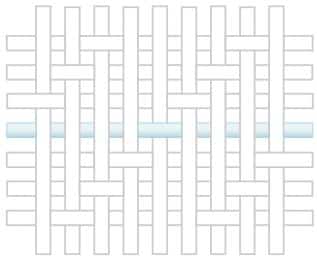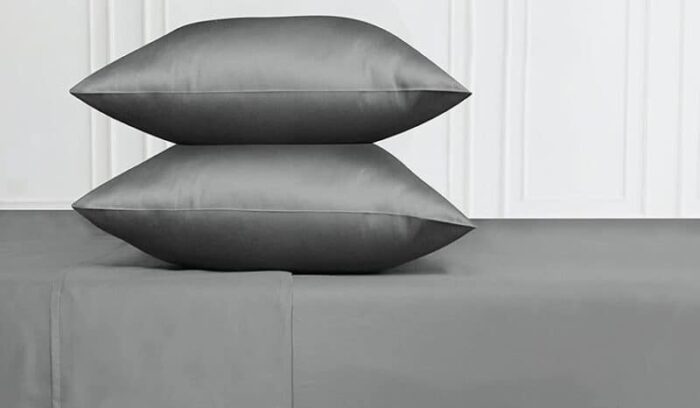Some of the finest bedding products on the market are made of sateen, satin, or Egyptian cotton.
Sateen sheets, for instance, are smooth and durable, with a luxurious feel. Egyptian cotton, on the other hand, tends to become softer in the long run.

But what is sateen and how does it differ from satin and cotton? First of all, know that sateen is a type of weave and not an actual fabric.
Generally, it’s made from cotton yarns by weaving three or four threads over one thread.
The final product has the drape and sheen of satin, but can be just as durable as cotton.
Feeling confused? The truth is that few consumers know the difference between sateen, satin, and other materials. But that’s why we’re here. Read on to learn more about sateen and how it compares to cotton and satin.
What Is Sateen?
The term “sateen” describes a weave pattern featuring three or more warp threads that go over one weft thread.
This material has been around since the mid-1800s. It’s prized for its smooth, silk-like feel and lustrous sheen. It can be just as luxurious as satin, but without the high price tag.
Premium sateen sheets and other bedding items are typically made from cotton. Manufacturers use short-staple spun yarns consisting of fibers with a staple length of 2.5″ or less. The fibers are tightly woven, resulting in a high thread count.
Depending on the brand, sateen products can be made from rayon, nylon, silk, or cotton blends. The material wrinkles less than satin and may not require ironing. Plus, it’s machine-washable and can be dyed or bleached.
Sateen isn’t cheap, but it often has a lower price than satin. Many consumers choose it over other fabrics for its low maintenance and luxurious feel. Note that sateen sheets tend to retain heat, which makes them suitable for cold sleepers.
How Is Sateen Used?
Nowadays, bedding stores offer a wide range of sateen products, from sheets and pillowcases to duvet covers. However, this material has many other uses across various industries.
For example, you can buy dresses, blouses, or even jackets made from sateen. Some stores also sell sateen robes, pajamas, and women’s lingerie. The garments made from this fabric are suitable for both everyday wear and special occasions, notes Tissura.
Sateen is a popular choice for upholstery and curtains, too.
It may also be used for:
- Evening gowns
- Nightgowns
- Athletic shorts
- Home decor items
- Cushion covers
- Scarves and other fashion accessories
This fabric comes in different weights and can be easily dyed, which allows manufacturers to use it in hundreds of products. It’s the closest thing you can get to satin.
Satin vs. Sateen: What’s the Difference?
Sateen and satin share many similarities, including their silky feel and luxurious, shiny look. These materials have the same weave pattern — four threads over and one thread under.
The main difference between the two is the type of fiber used.
Satin sheets, dresses, and other products are made with filament fibers, such as silk or nylon.
Sateen, on the other hand, is made from staple fibers that are a few inches long. Filament fibers can be of any length.

With that being said, let’s see other key differences between satin and sateen:
| Sateen | Satin |
|---|---|
| Made of short, staple fibers | Made of long filament fibers |
| More durable | Less durable |
| Can be dyed, bleached, or machine-washed | Generally hand wash or dry clean only |
| Less maintenance | More maintenance |
| Wrinkle resistant | Wrinkles easily and difficult to iron |
| Less expensive | More expensive |
Some consumers opt for polyester satin, which has a lower price tag. The downside is that polyester satin sheets wear out quickly.
Sateen vs. Egyptian Cotton: Similarities and Differences
Both sateen and Egyptian cotton sheets offer a luxurious feel and often cost more than regular sheets. But it’s not exactly comparing apples to apples.
The primary difference here comes down to weaves vs. fibers. And that single difference is a big one.

Weaves vs. Fibers
- Sateen is a weave—a pattern in which individual fibers are folded in order to create a fabric or textile. Other types of weaves include plain, twill, or herringbone.
- Egyptian cotton is a fiber—one of the strands which makes up the larger weave. Other types of fibers include polyester, microfiber, rayon, or linen.
By definition, you could have an Egyptian cotton sateen, where Egyptian cotton fibers are woven into a sateen weave pattern. In fact, many of the best sateens are made from Egyptian cotton and designed with this composition.
The Takeaway Point: Any fiber can be woven in any weave.
More often than not, when people are talking about traditional Egyptian cotton, they are referring to Egyptian cotton textiles woven into a percale weave, not a sateen weave.
Percale Weave
(one-over-one-under weave)

Sateen Weave
(four-under-one-over weave)

Generally, the percale weave (common with Egyptian cotton) produces textiles that are strong and durable, with a matte finish. With proper care, it can last for years.
On the other hand, the sateen weave tends to produce fabrics that have a silky feel with luxurious softness.
Are Sateen Sheets Worth It?
Sateen sheets cost anywhere between $50 and $200 or higher, depending on their size, brand, quality, and thread count.

This brings up the question, is sateen worth the price?
Top Features of Sateen
- Silky, soft, and breathable
- Drapes well
- Has a glossy finish
- Doesn’t always require ironing
- Wrinkles less than other bedding materials
- Relatively easy to clean and maintain
- Tends to resist mildew
- Feels warm and cozy
- Premium sateen sheets can last three years or longer
Our advice is to opt for quality sateen sheets, duvet covers, or whatever products you need. Cheap sateen sheets can lose their luster and fade in color after just a few washes.
Potential Drawbacks of Sateen Sheets
All bedding materials have potential drawbacks. Egyptian cotton, for example, is often mislabeled. Some manufacturers blend cotton with cheap fibers or use all sorts of tricks to inflate the thread count.

Disadvantages of Sateen
- Trapped heat: This material drapes closely to the body and traps heat, causing discomfort during warm summer nights. Generally, it’s not the best choice for hot sleepers.
- Pills and snags: It also tends to pill and snag due to its silky texture. Many consumers who use sateen sheets have a hard time keeping them in place at night. This problem may result in wrinkling.
- Chemical finish: Some manufacturers use chemicals to enhance its color and finish. For this reason, its shine may fade over time.
- Less breathable: Sateen is less breathable than cotton and may increase sweating.
- May cause allergic reactions: Sateen sheets that contain synthetic fibers are more likely to cause allergic reactions than cotton, linen, or silk.
Is Sateen a Good Choice for Sheets?
High-quality sateen can be a good choice for bedsheets. Its subtle sheen and silky finish offer a luxurious feel.
This material is suitable for cold sleepers, as it tends to be warmer and heavier than cotton. On top of that, it’s machine-washable and may not require ironing.
We hope we’ve answered your question, “what is sateen?” Now that you know what to expect, go ahead and explore your options. If you’re not sure what to choose, see our guide to microfiber sheets and our guide on thread count (spoiler: more isn’t always better).
FAQ
Sateen is a type of weave and cotton is the fiber from which weaves are made of. Sateen weave tends to produce fabrics that have a silky feel. Cotton typically has a plain weave (Egyptian cotton has a percale weave). Depending on the feel you’re going for sateen could be the better choice.
Compared to satin, sateen is more durable. Satin needs to be dry-cleaned or washed by hand, but sateen is machine washable and the weave pattern is not as delicate.
Citations
- The difference between Satin and Sateen. Dutch Label Shop. (n.d.). Retrieved October 19, 2021, from https://www.dutchlabelshop.com/en_ca/blog/difference-satin-sateen/.
- Gossypium barbadense (PROTA). Gossypium barbadense (PROTA) – PlantUse English. (n.d.). Retrieved October 19, 2021, from https://uses.plantnet-project.org/en/Gossypium_barbadense_(PROTA).
- Home. Tissura Fabrics: Main page. (n.d.). Retrieved October 19, 2021, from https://tissura.com/articles/sateen-fabrics.
- MediLexicon International. (n.d.). Polyester allergy: Symptoms, treatment, and prevention. Medical News Today. Retrieved October 19, 2021, from https://www.medicalnewstoday.com/articles/323566.
- UrbanDizajn. (2020, March 25). What is the difference between filament and staple fibers? Rilon. Retrieved October 19, 2021, from https://rilonfibers.com/blog/difference-between-filament-and-staple-fibers/.




